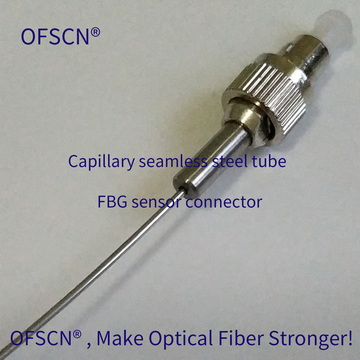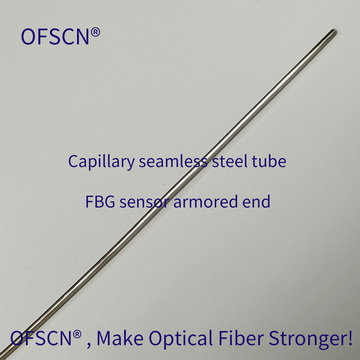This article introduces the concept of response time for FBG temperature sensors. It combines the packaging structure and material of OFSCN® Capillary Seamless Steel Tube Fiber Bragg Grating Temperature Sensors (FBG thermometers, FBG probes) to explain the reasons for their fast response time and high sensitivity.
1. Two Factors Affecting the Temperature Response Time of Fiber Bragg Grating Temperature Sensors: Thermal Conductivity and Thermal Conduction Distance
FBG temperature sensors have a very fast response time to the temperature changes of the measured object or environment, which mainly depends on the thermal conductivity of the materials used and the thermal conduction distance.
OFSCN® Capillary Seamless Steel Tube Fiber Bragg Grating Temperature Sensors (FBG thermometers) are used stainless steel seamless tubes to encapsulate the FBG. There is no adhesive or other substances used at the FBG, so the temperature of the measured object or environment is transferred solely through the stainless steel seamless tube.
 |
 |
|
Figure 1 |
Figure 2 |
The stainless steel material used in our sensors has a thermal conductivity coefficient (thermal conductivity) of approximately 0.16/(W/m℃)×10², which is considered good among various common materials. Therefore, temperature or heat can be transferred quickly.
At the same time, the OFSCN® Capillary Seamless Steel FBG Temperature Sensors come in sizes of 2.0mm, 0.9mm, and 0.6mm, which are already close to the limit in terms of packaging structure. As a result, the thermal conduction distance is short (see Image 3).
With fast speed and short distance, the response time is quick, and the temperature sensitivity is very high. Unfortunately, we cannot provide specific numerical values for the response time because we lack the means to measure it. If anyone in the industry has conducted tests in this area, we welcome communication to clarify this matter.
 |
|
Figure 3 |
2. Benefits of Fast Temperature Response in Fiber Bragg Grating Temperature Sensors
FBG demodulators have developed to the point where they can provide refresh rates of over 5000 Hz. This means that when using FBG sensors for temperature detection, temperature data can be generated more than 5000 times per second. However, I am not entirely sure if FBG temperature sensors can achieve such fast temperature changes.
Nevertheless, it is undeniable that OFSCN® Capillary Seamless Steel Tube FBG Temperature Sensors, produced by DCYS, utilize a unique stainless steel seamless tube patented packaging technology. Their structure is extremely simplified, without any adhesive or auxiliary materials, and their small size ensures an excellent response time to temperature changes in the measured object and environment.
 |
|
Figure 4 |
September 9, 2019, Update:
Through discussions with industry colleagues, it has been mentioned that tests with refresh rates above 1000 Hz have been conducted, which means that FBG sensors can reflect temperature changes of at least 1000 times per second. Due to the special structure and patented design advantages brought by DCYS, I am very confident in the sensitivity of OFSCN® Capillary Seamless Steel Tube FBG Temperature Sensors. However, due to limitations in testing methods and environments, we are currently unable to provide specific numerical values.
Our philosophy is: "OFSCN®, make optical fiber stronger!"
